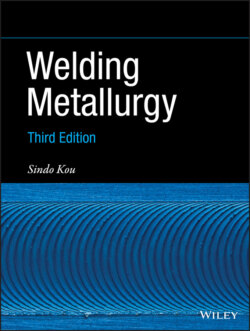Читать книгу Welding Metallurgy - Sindo Kou - Страница 82
Answer:
ОглавлениеAlong the x‐axis of the workpiece as shown in Figure 2.18,
(2.13)
Therefore, Eq. (2.9) becomes
(2.14)
Therefore, the temperature gradient is
(2.15)
From the above equation and
(2.16)
the cooling rate becomes
(2.17)
Without preheating the workpiece before welding,
(2.18)
With 250 °C preheating,
(2.19)
It is clear that the cooling rate is reduced significantly by preheating. Preheating is a common practice in welding high‐strength steels because it reduces the risk of HAZ cracking. In multiple‐pass welding the inter‐pass temperature is equivalent to the preheat temperature T 0 in single‐pass welding.
Thus, Eq. (2.17) shows that the cooling rate decreases with increasing Q/V, and Eq. (2.15) shows that the temperature gradient decreases with increasing Q.
Example 2.2 Consider 2D (x, y) heat flow and 3D (x, y, z) heat flow in the workpiece. (a) When heat flow in the workpiece is 2D, does the temperature distribution (including the weld width) change much in the depth direction of the workpiece? (b) What about 3D heat flow? (c) Which equation works better for the thick plate (25 mm thick) in Figure E2.2, and why? (d) How about the thin sheet (3.2 mm thick)? (e) At the same Q and V, how does preheating affect the weld width and cooling rate?
Figure E2.2 Transverse cross‐sections of welds.
